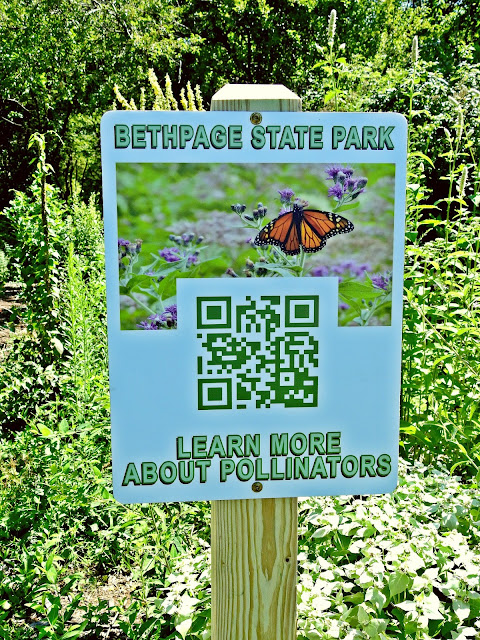Hummingbirds & Hummingbird Moths - Two Fascinating Pollinators at Bethpage State Park!
 |
| Both quick and foraging on the same flower - can you identify a Ruby-throated Hummingbird (left) and a Snowberry Clearwing (right)? |
Hummingbirds are a Common Favorite!
Tiny and fast, finding these iridescent creatures in your garden is always a treat! If granted with the opportunity to watch the wonder of these birds at work, you'll most likely find them feeding on a variety of flowers. If so, I recommend trying not to blink--in a flash, they might be gone!
 |
This of course makes hummingbirds not just efficient fliers, but outrageous pollinators!
Beating their wings up to 50 TIMES PER SECOND enables these magnificent birds to make a thousand or more floral visits a day! This also means that hummingbirds can drink up to double their weight in nectar! Incredible, right? Just imagine how much pollen they transfer throughout their daily feeding process (and even in their lifetime)!
Here at Bethpage State Park, Ruby-throated Hummingbirds have visited all our favorite locations! From the annual-tropical flower garden on #13 on the Black Course, to the arrangement of native flowers growing behind our Greenhouse... even to the native Jewelweed that lines the roads on the Blue Course. While spotting them may be difficult, we revel in the fact that they are around and do what we can to provide habitat for them. In fact, with a few simple tips, you can do just the same in your very own backyard!
- Plant tubular flowers; this shape provides easy nectar access for their elongated beaks.
- Hummingbirds are attracted to blooms that are pink, red, orange and yellow. The brighter the better! Unlike other pollinators, hummingbirds do not rely on their sense of smell so color is critical to enticing them to your garden.
- Install a sugar-water feeder and make it red! This will be a supplemental food source so make sure to place it near your hummingbird host plants for the best success!
- Interestingly enough, hummingbirds do not feed on nectar only! To keep their metabolism high for flight, they also need to eat insects for protein (and swallow them whole too). This means that your pollinator garden can feed these birds in more ways than one; think the aphids on your milkweed or the beetles and wasps that visit your blooms. All are possible forage choices for a hungry-hungry hummingbirds so be sure to have attractive plants to insects too!

Plant these native flowers to attract hummingbirds: Bee balm (top-left), Jewelweed (top-right), Meadow Sage (bottom-left), and Red Columbine (bottom-right).
Hummingbird Moths Hover Like the Bird but Look Like a Bee!
If hummingbirds are not unique enough, let me introduce you to the eccentricity of the hummingbird moth! That's right, at Bethpage State Park we have insects that move similar to the hovering bird and even share the same forage!
Hummingbird moths are in fact, a general term to describe multiple moth species that behave in this way. An example that visits our park, is the Snowberry Clearwing! To cause even more confusion, this hummingbird moth at quick glance might be mistaken for a giant bee. View the video and see for yourself!
This Snowberry Clearwing was feeding on Lantanas growing on the Greenhouse mat. In previous seasons, this species visited the Bee Balm in our Picnic Pollinator Garden. Using their proboscises to consume nectar, you can guess that it too is an incredible pollinator. A Snowberry Clearwing is one of the two hummingbird moths you can see in garden habitats on Long Island; the other species is the reddish-brown Hummingbird Clearwing.
How to Attract Snowberry Clearwings to Your Garden:
- As it's species name suggests, it's larvae favors the Snowberry plant! If you are on the West Coast, plant this native shrub in your garden! If you are on the East Coast, cherry trees or Dogbane will do.
- Dissimilar to the birds, these moths have a strong sense of smell! To play off that sense, be sure to plant the host plants all in one spot. This will ensure your garden is extra fragrant!
- If you want Snowberry Clearwings to revisit you next season, keep leaf litter in your garden and refrain from raking in autumn. Doing this provides perfect coverage and habitat for these moths to overwinter as pupae and emerge the following spring!





Comments
Post a Comment